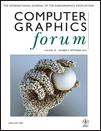Binary Shading Using Appearance and Geometry
Abstract
In the style of binary shading, shape and illumination are depicted using two colours, typically black and white, which form coherent lines and regions in the image. We formulate the problem of assigning colours in the rendered image as an energy minimization, computed using graph cut on the image grid. The terms of this energy come from two sources: appearance (shading) and geometry (depth and curvature). Our contributions are in the use of geometric information in determining colours, and how this information is incorporated into a graph cut approach. This optimization yields boundaries between black and white regions that tend towards being shorter and to run along geometric features like creases. We show a range of results, and demonstrate that this approach produces more coherent images than simpler approaches that make local decisions when assigning colours, or that do not use geometry.
References
- [BK04] Boykov Y., Kolmogorov V.: An experimental comparison of min-cut/max-flow algorithms for energy minimization in vision. IEEE Transactions on PAMI 26, 9 (Sept. 2004), 1124–1137.
- [BRO08] Bronson J., Rheingans P., Olano M.: Semi-automatic stencil creation through error minimization. In Proc. NPAR (2008), pp. 31–37.
- [BTM06] Barla P., Thollot J., Markosian L.: X-toon: An extended toon shader. In Proc. NPAR. D. DeCarlo and L. Markosian (Eds.). ACM (2006), pp. 127–132.
- [BVZ01] Boykov Y., Veksler O., Zabih R.: Fast approximate energy minimization via graph cuts. IEEE Transactions on Pattern Analysis and Machine Intelligence 23, 11 (2001), 1222–1239.
- [CGL*08] Cole F., Golovinskiy A., Limpaecher A., Barros H. S., Finkelstein A., Funkhouser T., Rusinkiewicz S.: Where do people draw lines ACM Transactions on Graphics 27, 3 (Aug. 2008), 88:1–88:11.
- [Dec96] Decaudin P.: Cartoon-Looking Rendering of 3D-Scenes. Technical Report 2919, INRIA , 1996.
- [DFRS03] DeCarlo D., Finkelstein A., Rusinkiewicz S., Santella A.: Suggestive contours for conveying shape. ACM Transactions on Graphics 22, 3 (2003), 848–855.
- [DR07] DeCarlo D., Rusinkiewicz S.: Highlight lines for conveying shape. In Proc. NPAR (2007), pp. 63–70.
- [FS76] Floyd R. W., Steinberg L.: An adaptive algorithm for spatial greyscale. In Proceedings of the Society for Information Display 17, 2 (1976), 75–77.
- [GCO06] Gal R., Cohen-Or D.: Salient geometric features for partial shape matching and similarity. ACM Transactions on Graphics 25, 1 (Jan. 2006), 130–150.
- [JDA07] Judd T., Durand F., Adelson E. H.: Apparent ridges for line drawing. ACM Transactions on Graphics 26, 3 (2007), 19.1--19.7.
- [KGV83] Kirkpatrick S., Gelatt C. D., Vecchi M. P.: Optimization by simulated annealing. Science 220 (1983), 671–680.
- [KI86] Kittler J., Illingworth J.: Minimum error thresholding. Pattern Recognition 19, 1 (1986), 41–47.
- [KZ93] Kamel M., Zhao A.: Extraction of binary character/graphics images from grayscale document images. Graphical Models and Image Processing 55, 3 (May 1993), 203–217.
- [LCP90] Lee S. U., Chung S. Y., Park R. H.: A comparitive performance study of several global thresholding techniques for segmentation. Computer Visualization, Graphics, and Image Processing 52 (1990), 171–190.
- [LL98] Leung C. K., Lam F. K.: Maximum segmented image information thresholding. GMIP 60, 1 (Jan. 1998), 57–76.
- [LMLH07] Lee Y., Markosian L., Lee S., Hughes J. F.: Line drawings via abstracted shading. ACM Transactions on Graphics 26, 3 (July 2007), 18:1–18:5.
- [LVJ05] Lee C. H., Varshney A., Jacobs D. W.: Mesh saliency. ACM Transactions on Graphics 24, 3 (Aug. 2005), 659–666.
- [MG08] Mould D., Grant K.: Stylized black and white images from photographs. In Proc. NPAR (2008), pp. 49–58.
- [OH95] Ostromoukhov V., Hersch R. D.: Artistic screening. In Proc. SIGGRAPH (1995), pp. 219–228.
- [OH99] Ostromoukhov V., Hersch R. D.: Multi-color and artistic dithering. In Proc. SIGGRAPH (1999), pp. 425–432.
- [RBD06] Rusinkiewicz S., Burns M., DeCarlo D.: Exaggerated shading for depicting shape and detail. ACM Transactions on Graphics 25, 3 (July 2006), 1199–1205.
- [RKB04] Rother C., Kolmogorov V., Blake A.: “Grabcut”: Interactive foreground extraction using iterated graph cuts. ACM Transactions on Graphics 23, 3 (2004), 309–314.
- [SDM06] Spindler M., DëȨhring N. R. R., Masuch M.: Enhanced cartoon and comic rendering. In Proceedings of Eurographics Short Papers (2006), pp. 141–144.
- [TFFR06] Toler-Franklin C., Finkelstein A., Rusinkiewicz S.: Illustration of complex real-world objects using images with normals. In NPAR (2006), pp. 111–119.
- [Uli87]
Ulichney R.: Digital Halftoning. MIT Press, 1987.
10.7551/mitpress/2421.001.0001 Google Scholar
- [VBGS08] Vergne R., Barla P., Granier X., Schlick C.: Apparent relief: A shape descriptor for stylized shading. In Proc. NPAR (2008), ACM, pp. 23–29.
- [VPB*09] Vergne R., Pacanowski R., Barla P., Granier X., Schlick C.: Light warping for enhanced surface depiction. ACM Transactions on Graphics 28, 3 (2009), 1–8.
- [WXSC04] Wang J., Xu Y., Shum H.-Y., Cohen M. F.: Video tooning. ACM Transactions on Graphics 23, 3 (2004), 574–583.
- [XK08] Xu J., Kaplan C. S.: Artistic thresholding. In Proc. NPAR (2008), pp. 39–47.
- [XKM07] Xu J., Kaplan C. S., Mi X.: Computer-generated papercutting. In Pacific Graphics (2007), pp. 343–350.
- [YB89] Yanowitz S. D., Bruckstein A. M.: A new method for image segmentation. Computer Visualization, Graphics, and Image Processing 46, 1 (1989), 82–95.




